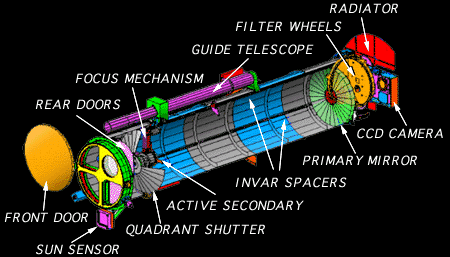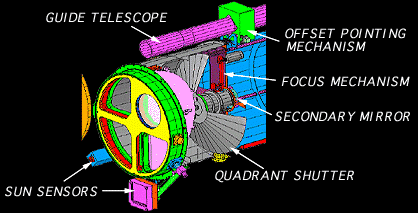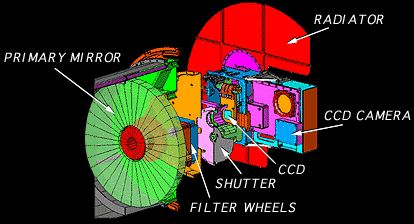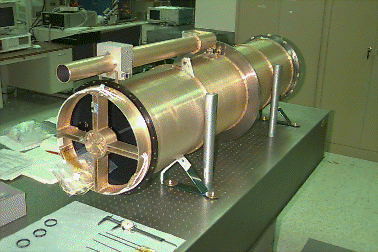For a look at a current NASA solar telescope in space with beautiful and amazing images, visit the Solar Dynamic Observatory (SDO) page. Another mission, STEREO, is using its two spacecraft telescopes to study the Sun in 3-D!
An earlier successful solar telescope in space was called TRACE. Building a solar telescope to collect high energy radiation such as Extreme UltraViolet (EUV) and X-rays is not trivial. Building them big enough to see the Sun in as much detail as possible adds to the difficulty. Unlike Earth-bound telescopes, the space-borne ones have to be designed to fit on a rocket and they have to be robust enough to survive the launch.
To get a feel for what is involved in building a telescope to observe EUV radiation from the Sun we will take a look at the Transition Region And Coronal Explorer (TRACE) instrument which was built at Lockheed Martin Solar and Astrophysics Laboratory and launched on April 2, 1998. The picture below shows the cut-away view of the inside of the TRACE telescope.
TRACE Instrument

The front opening of the TRACE telescope was only 30 cm across and 187cm long. This combination, in part, allowed TRACE to see an area on the Sun of approximately 360,000km x 360,000km. A typical TRACE image is made up of 1.05 million small squares called pixels, each 350km on a side. The main telescope of TRACE consists of a primary mirror near the back of the instrument and a smaller secondary mirror near the front which can be moved to help change focus.
What made TRACE different from most previous telescopes that you are used to is the fact that it controls the kind of light which gets through to the detector which can be seen behind the primary mirror in the image above (the CCD camera). The trick used was to coat the two mirrors with special materials which blocked out certain bands of light and let through others (much like red cellophane can be used to filter out all other colors but red). Each mirror is divided into four quadrants and each quadrant has a different coating.

The special coatings were devised so that a particular wavelength of radiation could get through. The four TRACE coatings were chosen to select three separate EUV bands and one UV band:
- Coating 1: EUV 171A band:
- Coating 2: EUV 195A band:
- Coating 3: EUV 284A band:
- Coating 4: UV broad band:
|
T = 1 million degrees
T = 1.5 million degrees
T = 2.5 million degrees
T = 4,000-250,000 degrees
|
As indicated in the table, the EUV bands are sensitive to coronal temperatures of about 1 to 3 million Kelvin, while the UV filters respond primarily to the temperature regimes of the photosphere, chromosphere, and transition region.
Once the EUV and UV light gets through the telescope it has to be recorded. This is done by using a very high quality digital camera called a CCD camera:

Finally, a very powerful computer is used to handle the large amounts of data taken by TRACE. This computer puts the data in a form for transmission to the ground (see today's activities) and sends it to the radio transmitter for download.

The completed TRACE instrument prior to launch
TRACE was then attached to the spacecraft and launched into an orbit about the Earth that gave it an uninterrupted view of the Sun for most of a year.
Back to today's topic